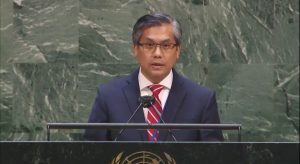Over the past week, evidence has emerged of a massacre by Myanmar’s military regime in the country’s northwest, where the bodies of around 40 people were discovered during the course of July.
The bodies were found in several different locations around Kani, a town on the Chindwin River in Sagaing Region, which has seen fierce fighting in recent months between the Myanmar armed forces and militia groups set up by opponents of military rule.
The bodies of around 40 people were killed by soldiers, according to residents. “Junta troops raided our villages. We fled and found corpses when we came back to the villages,” one resident told local media.
The most recent discovery, Myanmar Now reported, was that of 12 charred corpses, including that of a 14-year-old boy, which were found in a wooded area near the village of Taung Pauk on July 30. The discovery was reportedly made a few days after military forces entered Taung Pauk and other nearby villages and began arresting male residents suspected of involvement in the anti-coup resistance.
According to Myanmar Now, this discovery followed two earlier discoveries of bodies that had been dumped in other parts of the township, following military raids and clashes between the security forces and members of a local militia.
This week, Myanmar’s ambassador to the United Nations, who broke with the junta in February and remains loyal to the ousted civilian government, alerted the world body to the “reported massacre” in Kani. In a letter to U.N. Secretary General Antonio Guterres, Ambassador Kyaw Moe Tun described the discovery of the 40 bodies, describing the incidents as “clearly amounting to crimes against humanity” and calling for an urgent intervention.
“There is no sign of easing atrocities, killing, arrest committed by the military,” he wrote in the letter. “We demand for urgent humanitarian intervention from the international community before it is too late.”
The discoveries in Kani provides yet more evidence of the violent lengths to which the administration, which recently rebranded itself as a “caretaker government,” is willing to go to quash the simmering anti-coup resistance. It also demonstrates that the resistance is far from exhausted.
Sagaing Region in northwest Myanmar has been a center of armed anti-coup struggles since the shadow National Unity Government (NUG) announced the formation of a People’s Defense Force in early May, to combat the military and form the kernel of a future Federal Army.
Since then, civilian militia groups have sprang up in all parts of the country, and some have launched deadly attacks on junta troops with makeshift weapons and homemade hunting rifles. While some have adopted the PDF moniker, their actions have nearly all been localized and uncoordinated. But the NUG, which includes political activists, ethnic minority organizations, and members of Aung San Suu Kyi’s National League for Democracy, appears to be readying for a nationwide uprising.
In an interview with Myanmar Now published today, NUG Defense Minister Yee Mon said that the underground government had been in contact with most of the PDF chapters across the country and was hoping to bring them under a unified command. Noting that a the creation of a unified chain of command was important for the success of the struggle, he urged Myanmar’s people “to unite under the same flag once and for all.”
Yee Mon added that the NUG was “planning to arm the on-the-ground revolutionary forces with as many weapons as possible,” including by seizing them in hit-and-run attacks on the military. His interview followed a Facebook post in which he declared: “We are prepared for the end game of the revolution.”
Yet few military analysts believe that even a unified PDF can pose an existential threat to the Tatmadaw, as long as the officer corps remains united. As Peter Morris noted in a recent article in Asia Times, Yee Mon “is walking a fine line between satisfying an impassioned public’s desire for quick action and the practical challenge of a huge power imbalance between the Tatmadaw and the PDF in terms of weapons and soldiers.”
As the recent events in Kani have clarified, the military is playing for keeps and has no compunction about employing savage violence in order to safeguard its hold on power. At the same time, popular anger and desperation remains such that continued civilian resistance is almost certain. Barring some sort of black swan occurrence – a split in the upper echelons of the military, or mass defections from the ranks – the most likely outcome is not victory for either side, but instead a protracted, grinding stalemate.

































